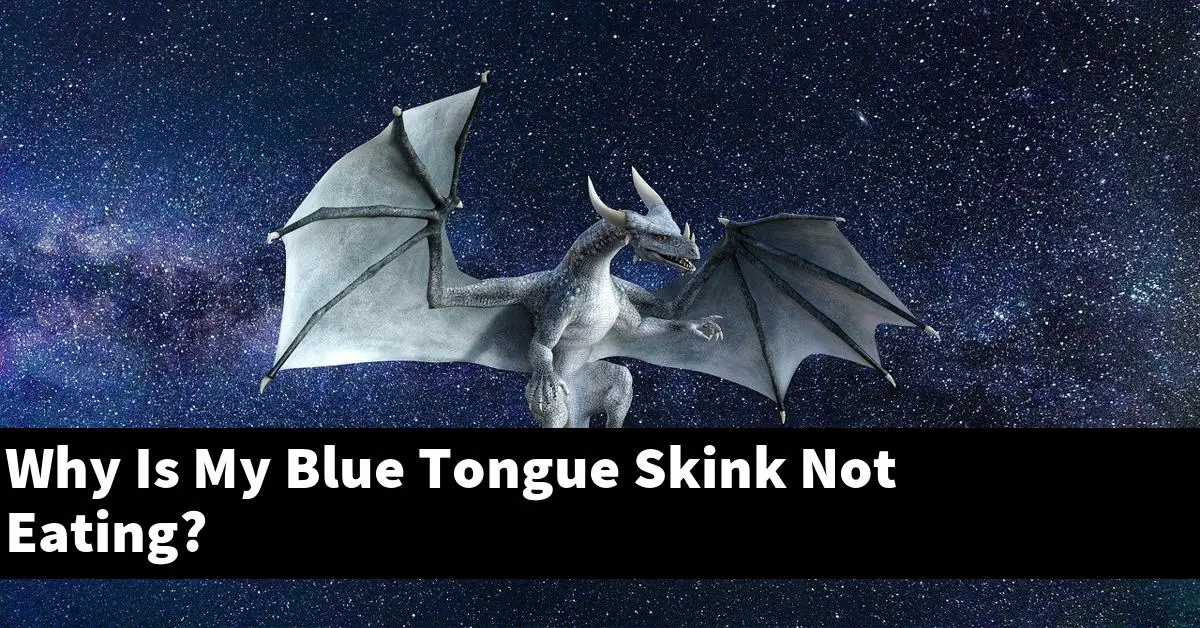If you’re wondering why your blue tongue skink isn’t eating, you’re not alone. In this blog post, we’ll explore some of the possible reasons why your skink might not be interested in food and what you can do about it.
Table of Contents
How can you tell if a blue tongue skink is dehydrated?
A blue tongue skink can become dehydrated for various reasons, including not having enough water available, not being able to absorb water properly, or losing too much water through evaporation. The most common symptom of dehydration in lizards is sunken eyes.
Other signs include a dull appearance, dry skin, and lethargy. If you suspect your blue tongue skink is dehydrated, offer it a shallow dish of water and see if it drinks. If it does not drink, you will need to provide supplemental hydration, either through subcutaneous fluids or by soaking the lizard in a warm water bath.
What do you do if your skink won’t eat?
If your skink is not eating, it is important to take note of when the last time it ate was and what it ate. If your skink hasn’t eaten in a while, it is important to take it to the vet to make sure there isn’t an underlying health issue. If your skink has only recently stopped eating, there are a few things you can try.
- First, make sure that the food you are offering is fresh and appropriate for your skink. If the food is old or spoiled, your skink is unlikely to want to eat it.
- Second, try offering a variety of food items to see if your skink will eat something it wasn’t previously interested in.
- Third, make sure that the temperature in your skink’s enclosure is appropriate. If it is too hot or too cold, your skink may not want to eat.
If you have tried all of these things and your skink still isn’t eating, it is important to take it to the vet to rule out any health issues.
How can you tell if a blue tongue lizard is dehydrated?
Dehydration is a big problem for blue tongue lizards, and it can be hard to tell if your lizard is dehydrated. Some signs of dehydration include weight loss, sunken eyes, dry skin, and lethargy. If you think your lizard may be dehydrated, take it to the vet for a check-up.
Why is my blue tongue lizard not eating?
There are a number of reasons why your blue tongue lizard may not be eating.
It could be that the lizard is sick, or that its habitat is not ideal. If you’ve recently moved the lizard to a new enclosure, it may be stressed and not eating as a result.
Additionally, blue tongue lizards are known to go off their food during the winter months. If it is winter where you live, this may be why your lizard is not eating.
If you are concerned that your lizard is not eating, take it to a reptile veterinarian for a check-up. They will be able to determine if the lizard is sick or if there is something wrong with its habitat.
How do I get my skink to eat?
If your skink is not eating, the first thing you should do is check its habitat to make sure that it is clean and has everything it needs. Skinks are very clean animals and will not eat in a dirty environment. If everything looks clean and in order, the next step is to check the food you are offering.
Skinks are insectivores, so make sure you are offering them a diet that consists mostly of insects. Live food is best, but you can also offer them frozen or dried insects. If you are offering the right food and your skink still is not eating, it may be sick. In this case, you should take it to a reptile vet for a check-up.
How often do blue tongue skinks eat?
It is generally recommended that blue tongue skinks be fed every day or every other day. This schedule can vary depending on the individual skink, however, so it’s best to consult with a veterinarian or reptile specialist to determine the best feeding schedule for your pet.
Blue tongue skinks are omnivores, so their diet should consist of both plant and animal matter. A variety of fresh fruits, vegetables, and insects should be offered, and the food should be chopped or shredded into small pieces to make it easier for the skink to eat.
How to tell if your Blue Tongue Skink is sick
If you have a Blue Tongue Skink as a pet, you may be wondering how to tell if it is sick. There are several things you can look for to determine if your Blue Tongue Skink is unwell.
- First, take a look at its appearance. A healthy Blue Tongue Skink should have bright, clear eyes and smooth, shiny skin. If your Blue Tongue Skink’s eyes are cloudy or its skin is dull and dry, it may be sick.
- Next, observe your Blue Tongue Skink’s behavior. A healthy Blue Tongue Skink should be active and alert. If your Blue Tongue Skink is lethargic and inactive, it may be sick.
- Finally, check your Blue Tongue Skink’s eating habits. A healthy Blue Tongue Skink should have a good appetite and eat regularly. If your Blue Tongue Skink is not eating or has a decreased appetite, it may be sick.
- If you notice any of these signs, it is important to take your Blue Tongue Skink to the vet for a check-up.
Summary
A blue tongue skink not eating can be a sign of a health problem. If your blue tongue skink is not eating, it is important to take it to the vet to find out the cause. There are many possible causes of a blue tongue skink not eating, including mouth problems, gastrointestinal problems, and stress.


